How to Understand the Social Needs of Parakeets
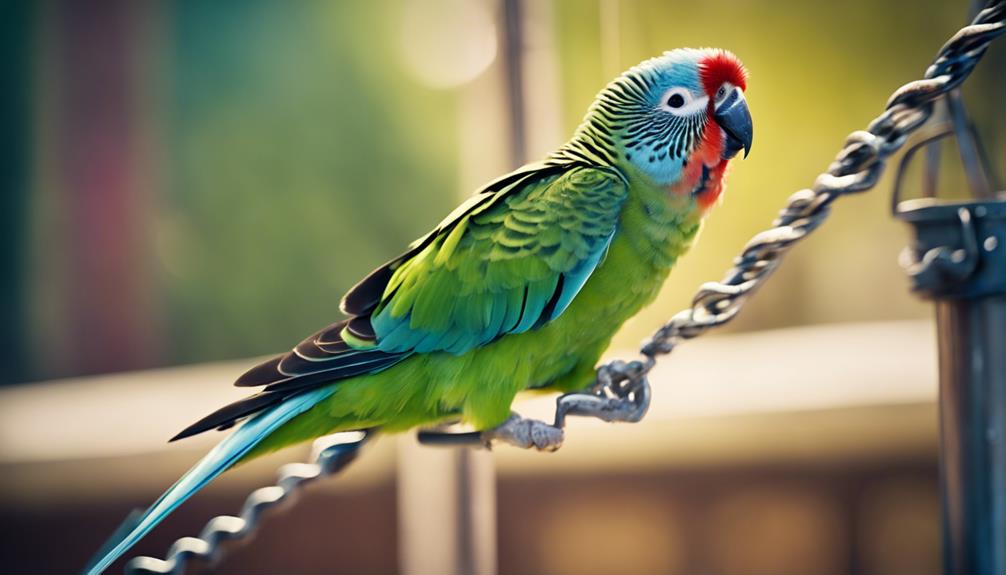
Parakeets are highly social birds that thrive on companionship. In the wild, they live in flocks and rely on each other for various activities such as foraging, nesting, and grooming. When kept as pets, parakeets still have this innate need for social interaction.
Providing your parakeet with a companion can greatly enhance their quality of life. They will have someone to chirp with, play with, and preen each other. This can help prevent loneliness and boredom, which are common issues in solitary parakeets.
However, it's essential to introduce new birds properly to avoid aggression or territorial behavior. Slowly introducing them in a neutral space and monitoring their interactions can help ensure a harmonious relationship.
Understanding the social needs of parakeets and providing them with appropriate companionship can lead to a fulfilling and enriching relationship for both you and your feathered friends.
Key Takeaways
- Parakeets thrive on companionship and social interaction for their well-being.
- Companionship prevents loneliness, boredom, and promotes natural behaviors.
- Engaging activities and a social environment support parakeets' mental enrichment.
- Effective communication and understanding their signals create a nurturing bond.
Social Behavior of Parakeets
Parakeets actively seek social interaction to fulfill their natural need for companionship and communication. These vibrant birds exhibit intricate social behaviors both in the wild and as pets. In their natural habitat, parakeets live in flocks, relying on socialization for survival and emotional well-being. When kept as pets, they transfer this flocking behavior to their human caregivers, forming strong bonds with them.
Parakeets communicate through a variety of channels, including vocalizations, body language, and physical contact. They use chirps, squawks, and other sounds to express their emotions and establish connections with others. Additionally, their body language, such as fluffing feathers or gentle nibbling, plays a crucial role in maintaining social bonds.
Failure to provide adequate social interaction can have detrimental effects on parakeets. Loneliness and boredom can lead to behavioral issues, stress, and even health problems. Thus, meeting their social needs through companionship and engagement is vital for ensuring the well-being of these sociable birds.
Importance of Parakeet Companionship
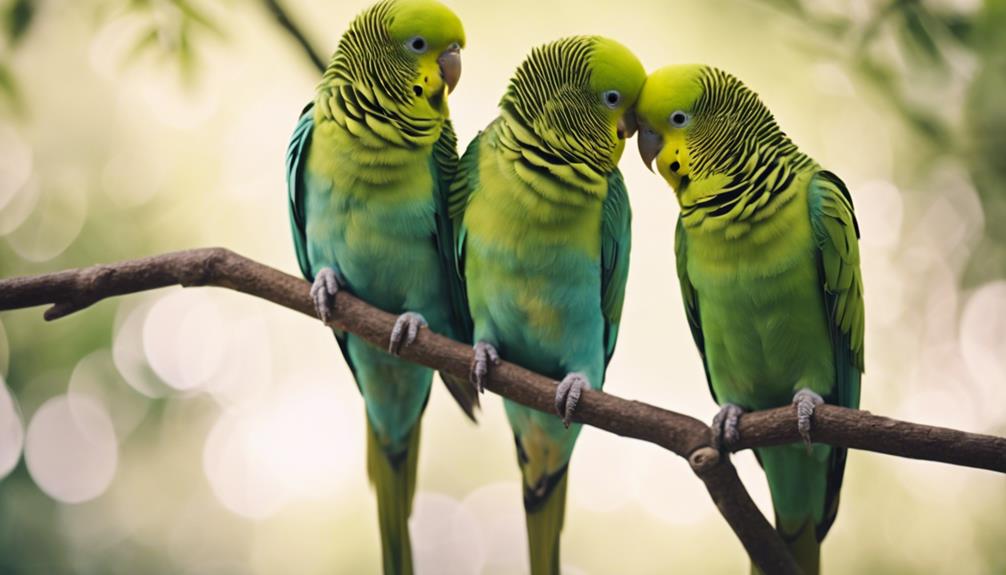
In the realm of avian companionship, the importance of social interaction for parakeets can't be overstated. Parakeets are social birds, thriving on companionship and interaction with their own kind. They love having a companion parakeet as it helps prevent loneliness and boredom, leading to a happier and mentally stimulated bird.
When paired, parakeets engage in natural behaviors like preening, playing, and vocalizing together. This companionship often results in lively conversations, mimicry of sounds, and shared activities within the cage. Socializing with another parakeet provides mental enrichment and a sense of security for these sociable birds, fulfilling their need for social interaction and communication.
Understanding the significance of parakeet companionship is vital in ensuring the well-being and happiness of these intelligent and social creatures. Parakeets love to bond with their feathered friends, creating a harmonious environment that nurtures their social nature.
Creating a Social Environment for Parakeets
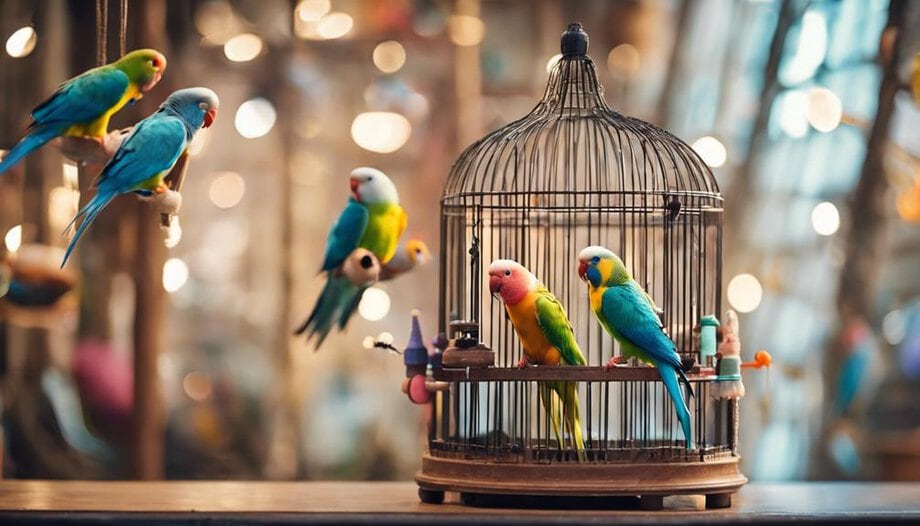
Thriving in a social environment, parakeets benefit greatly from regular interactions with their own kind or with humans. These social creatures require proper socialization to ensure their well-being.
To create a social environment for parakeets, consider the following:
- Companionship: Providing other parakeets as companions can prevent loneliness and foster a sense of belonging for your feathered friends.
- Human Interaction: Regular interaction with humans can help parakeets feel comfortable and secure, leading to a more enriched social life.
- Engaging Activities: Parakeets enjoy activities like playing with toys or exploring their surroundings together, promoting bonding and mental stimulation.
- Safe Environment: Ensuring a safe and spacious area for social interactions is essential for properly socialized parakeets to thrive.
Understanding Parakeet Communication
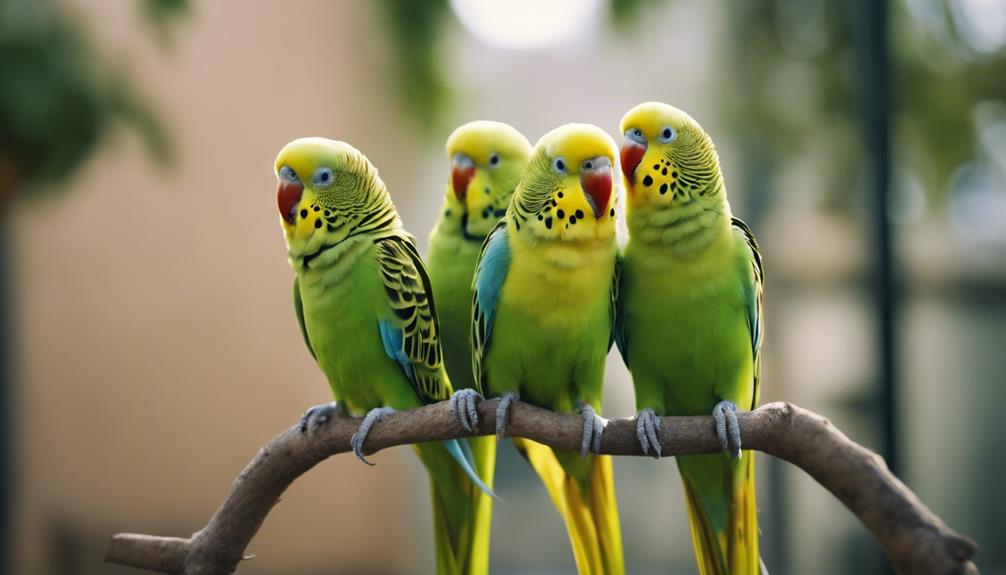
Communication among these vibrant birds encompasses various forms, including vocalizations, body language, and touch, allowing them to convey their needs and emotions effectively. Parakeets are intelligent birds that can learn to mimic human speech, with male budgies showing a higher inclination for this than females. Their ability to recognize human faces and differentiate between voices highlights their cognitive capacities.
Understanding a parakeet's communication cues is crucial, as signs of stress like biting, screaming, or feather picking indicate their emotional state. It's essential to approach these birds with gentleness, as yelling can distress them and harm their well-being. By paying close attention to their vocalizations, body movements, and responses to touch, one can establish a deeper bond with these intelligent creatures.
Effective communication with parakeets involves creating a safe and nurturing environment where they feel understood and cared for, fostering a harmonious relationship between birds and their human companions.
Meeting Parakeets' Social Needs
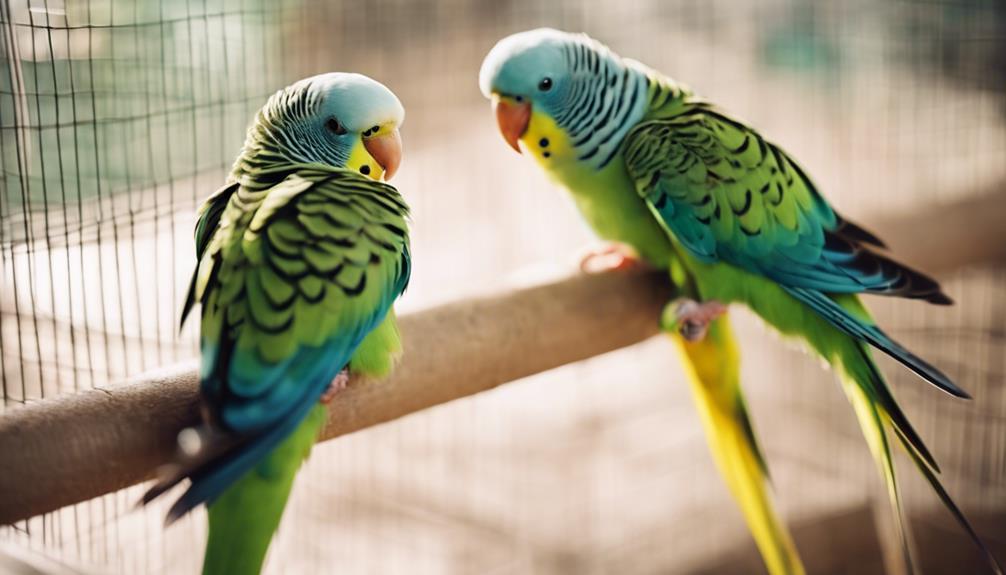
Parakeets are highly social creatures that require daily socialization to thrive. Providing them with cage companionship is crucial to prevent feelings of loneliness and boredom.
Understanding their flock behavior helps in creating a harmonious environment that caters to their social needs.
Socializing Parakeets Daily
Regular human contact aids in fostering a sense of security and trust within parakeets, contributing to their overall well-being and social development. Daily socialization is crucial for mental stimulation and preventing loneliness in these social birds. To ensure a happy and well-adjusted parakeet, owners should engage in consistent interactions.
Here are some key ways to socialize parakeets daily:
- Spend time talking and singing to your parakeet to create a bond.
- Offer treats by hand to establish a positive association.
- Provide varied toys and activities to keep them entertained.
- Allow supervised out-of-cage time for exploration and exercise.
Providing Cage Companionship
When considering the social needs of parakeets, providing cage companionship plays a crucial role in promoting their mental stimulation and well-being. Multiple parakeets in a cage can engage in various social interactions that mimic their natural behavior in the wild. This companionship helps prevent loneliness, reduce stress, and decrease negative behaviors. Introducing a same-sex cage companion gradually ensures a smooth adjustment and fosters a positive relationship between the birds. Pairing parakeets together can lead to engaging activities, such as mimicry of sounds and increased overall well-being. The table below highlights the benefits of cage companionship for parakeets:
| Benefits of Cage Companionship |
|---|
| Prevents loneliness |
| Reduces stress |
| Decreases negative behaviors |
Understanding Flock Behavior
Understanding the intricate dynamics of flock behavior among parakeets sheds light on their social needs and interactions within a communal setting. Parakeets are highly social birds that rely on social interaction for their well-being.
When considering flock behavior in parakeets, it's crucial to note that:
- Parakeets engage in grooming activities to strengthen social bonds.
- Vocalizing is a key aspect of their social interaction within a flock.
- Playful activities play a significant role in fostering social connections among parakeets.
- Loneliness can have detrimental effects on parakeets, leading to stress and behavioral issues.
Recognizing and addressing the social needs of parakeets is essential to prevent loneliness and ensure their mental health and overall happiness.
Bonding Activities for Parakeets
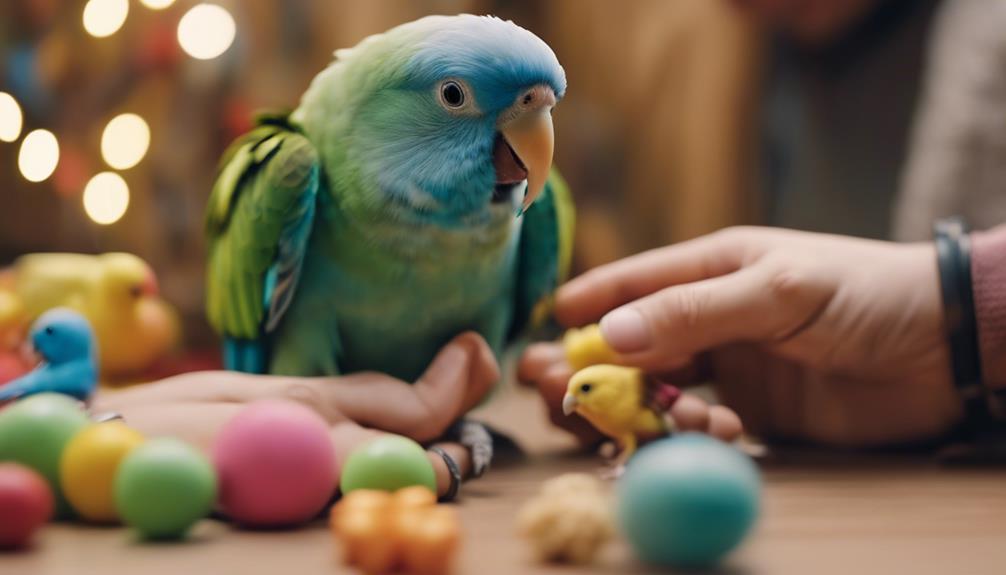
To strengthen the bond with your parakeet, engage in daily handling and gentle petting sessions. This routine helps your feathered friend become accustomed to your touch and presence, fostering trust and familiarity.
Offering treats by hand is another effective bonding activity. By doing so, you create positive associations with yourself, reinforcing the bond between you and your parakeet.
Spending time talking to your parakeet in a soothing voice is also beneficial. This practice helps them get used to your sound and develops a connection through vocal interaction.
Interactive toys and activities play a significant role in enhancing bonding. Providing your parakeet with stimuli that encourage play and engagement can strengthen the bond by creating shared experiences.
Additionally, incorporating training sessions with positive reinforcement can establish effective communication channels, build trust, and deepen the bond between you and your feathered companion.
Recognizing Parakeet Loneliness
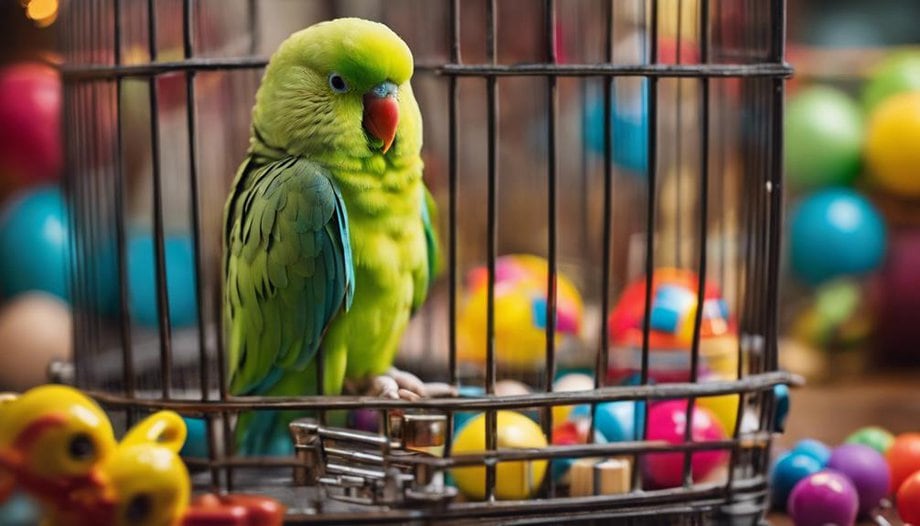
Bonding activities are crucial for nurturing a strong connection with your parakeet, but it's equally important to be attentive to signs of loneliness in these social birds. Loneliness in parakeets can have detrimental effects on their well-being, leading to stress, depression, and even health issues.
To recognize and address parakeet loneliness effectively, consider the following:
- Excessive Vocalization: If your parakeet is constantly chirping or squawking, it could be a sign of loneliness and a cry for companionship.
- Feather Plucking: Parakeets may engage in feather plucking when they're lonely, seeking comfort in this self-destructive behavior.
- Decreased Activity: A lack of energy and decreased interest in playing or exploring their environment could indicate feelings of loneliness in your parakeet.
- Providing a Companion: Introducing another parakeet as a companion can significantly reduce loneliness and improve the mental well-being of your feathered friend.
Understanding and addressing parakeet loneliness is essential for ensuring their happiness and overall quality of life.
Frequently Asked Questions
How Do You Socialize a Parakeet?
To socialize a parakeet, engage in interactive playtime and provide stimulating toys. Gradually introduce them to other birds for companionship. Hand-feeding fosters trust. Regular attention and positive reinforcement from the owner strengthen the bond and ensure socialization.
How Much Socialization Do Parakeets Need?
Parakeets require consistent socialization to thrive. Group playtime and bird buddies are essential for their mental well-being. A minimum of 1-2 hours of daily interaction helps prevent loneliness and behavioral issues. Strong bonds are formed through attention, affection, and companionship.
How Much Interaction Does a Parakeet Need?
Parakeets thrive with 1-2 hours of playtime daily, split into shorter sessions. Consistent interaction is vital for their happiness and health. Keeping them socially engaged prevents boredom. Cage enrichment and varied attention keep them content.
What Are Signs of a Happy Parakeet?
A happy parakeet shows joy through vocal cues and playful behavior. Bright eyes, chirping, and active interaction indicate contentment. Exploration, interest in toys, and a trusting demeanor towards caregivers are signs of a happy parakeet.











